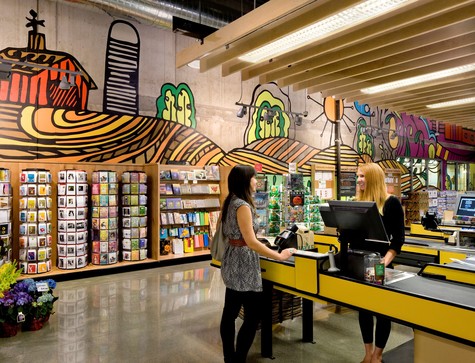
Change is Coming to a Grocery Near You
By Katherine
Blanner
Understanding your customer has always been the bread-and-butter of the grocery business. Historically, as grocery markets expanded beyond the neighborhood format, getting larger and less personalized, they lost the spark that makes for a great customer experience. Now grocers are utilizing technology, new store formats, and experiential retail to regain that connection with their clientele.
I recently attended GroceryShop, one of the largest conferences for the grocery industry. The conference brought together industry leaders who are facing major challenges: shifting demographics, higher service expectations, and advancing technology. The customer is in control, and stores are scrambling to catch up.
New Store Formats & Footprints
Grocery is no longer a one-size-fits-all application. The industry is exploring sizes and formats to cater to geographic and demographic needs. These new formats might feature a dedicated space for pick-up groceries, delivery options, revitalized center stores, or more self-check-out technology. There was talk about how the overall store footprint since 2010 has shrunk by 15%, with a smaller, more curated stock.
However, Kroger made the interesting point that a larger format store can have more flexibility because it can be sectioned off for order processing, warehouse distribution, or self-checkout. But it has to be targeted toward that store’s specific customer needs.
Millennials Want Experiential Retail
One question that was on everyone’s mind is: what do Millennials want? In general, Millennials value experiences over tangible things. Many groceries are trying to provide those experiences to increase shopping trips. Some European models include what they call “cross shop,” combining the things shoppers need to do with the things they want to do. We’ve seen that in U.S. applications as well, including a lot of the grocery stores we’ve designed, such as including taprooms in Whole Foods or cooking schools and restaurants in Draeger’s.
We’re also seeing stores cater to the desire for convenience. Not always doing your weekly grocery shopping but tailoring it down to picking up some wine and snacks and going to the park to meet your friends. Some are targeting the health-conscious and others want to create a neighborhood hangout space. Retailers are trying to think about those different experiences that Millennials value.
Technology & Data Chaos
How can technology enhance the customer experience? That’s the big question. Again, the answer has to do with location and demographics. Some customers and store employees might be able to embrace working with Artificial Intelligence (AI) or robots, but another, older customer base may not want to see robots zooming around the store taking inventory. Self-check-out technology is another instance where success or failure might be dependent on understanding your demographic.
It’s clear that we’re in an era of testing and experimentation with technology. Digital aisle labeling technology is one example. At first, grocers thought this tech would save manpower, and they were enthusiastic about rolling it out, but it hasn’t been developed to a point where it can become mainstream.
One interesting case study was a retailer (Schnuck Markets) using IoT devices to replace manual temperature logs, helping to advance their “best and fresh” initiative. This retailer was able to keep their products at safer temperatures and therefore create a lot less waste. It’s exciting to think about the ways in which we can promote sustainability through these new store technologies.
Data-driven retail strategies including eCommerce, loyalty programs, and supply chain tracking bring a new challenge: how can store owners bring order to the chaos that all this data creates? And how do they know which data to focus on? The consensus at GroceryShop was that using the wrong data is worse than not using data at all. Furthermore, data is perishable: it needs to evolve with the customer.
One thing is for sure: the next few years will be full of change in the grocery industry, and grocers are looking for trusted advisors to help them position their stores to better serve their customers. Keeping customer needs at the forefront, and ensuring store design facilitates an exceptional customer experience, will lead to nothing less than a revolution in how we shop for food.



